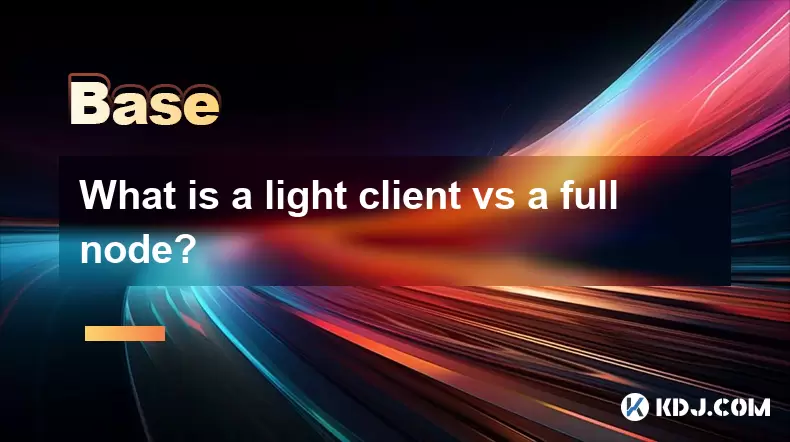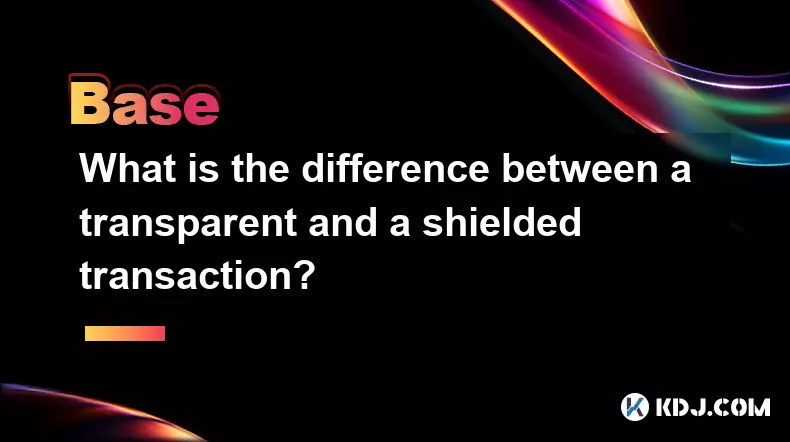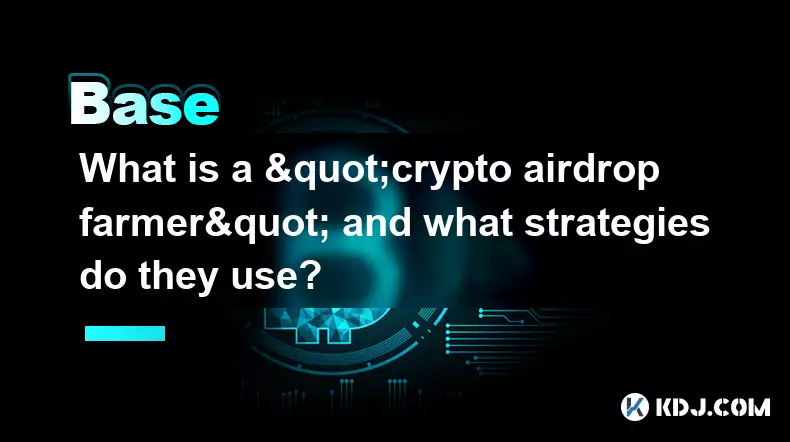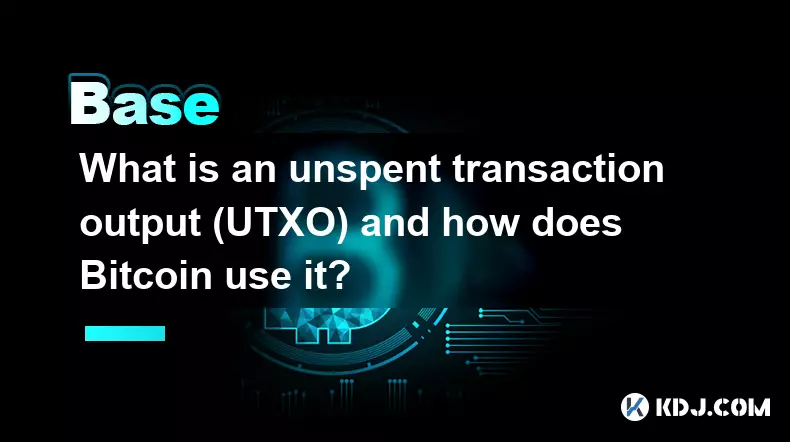-
 bitcoin
bitcoin $102205.214190 USD
-0.72% -
 ethereum
ethereum $3436.907575 USD
0.47% -
 tether
tether $0.999747 USD
0.00% -
 xrp
xrp $2.416990 USD
1.20% -
 bnb
bnb $955.051727 USD
-0.51% -
 solana
solana $152.780777 USD
-0.84% -
 usd-coin
usd-coin $0.999744 USD
-0.01% -
 tron
tron $0.294712 USD
-1.35% -
 dogecoin
dogecoin $0.171050 USD
-0.28% -
 cardano
cardano $0.550996 USD
-0.97% -
 hyperliquid
hyperliquid $38.626379 USD
-0.84% -
 chainlink
chainlink $15.308225 USD
0.01% -
 bitcoin-cash
bitcoin-cash $515.492897 USD
2.05% -
 stellar
stellar $0.281858 USD
0.11% -
 unus-sed-leo
unus-sed-leo $9.148114 USD
-0.65%
Was ist ein leichter Client gegenüber einem vollständigen Knoten?
A full node validates all transactions independently, ensuring security and decentralization, while light clients rely on full nodes for faster, resource-efficient access to the blockchain.
Jul 09, 2025 at 11:57 am

Das Konzept eines vollständigen Knotens verstehen
Ein vollständiger Knoten ist ein Programm, das Transaktionen und Blöcke auf einer Blockchain vollständig validiert. Es lädt eine vollständige Kopie des Blockchain -Ledgers herunter und überprüft unabhängig jede Transaktion, ohne sich auf Dritte zu verlassen. Dies stellt sicher, dass alle Regeln des Kryptowährungsprotokolls befolgt werden.
Das Ausführen eines vollständigen Knotens erfordert erhebliche Speicherplatz, Bandbreite und Verarbeitungsleistung, insbesondere für große Blockchains wie Bitcoin oder Ethereum. Der Knoten speichert den gesamten Transaktionsgeschichte , erzwingt Konsensregeln und gibt gültige Transaktionen an andere Knoten im Netzwerk weiter.
Durch die Aufrechterhaltung einer vollständigen Kopie der Blockchain trägt ein vollständiger Knoten zur Dezentralisierung und Sicherheit. Es verhindert betrügerische Aktivitäten, indem es jede Transaktion gegen ihre eigene validierte Geschichte überprüft. Jeder Versuch, Münzen auszugeben, die nicht existieren oder gegen Protokollregeln verstoßen, wird vom vollständigen Knoten abgelehnt.
Was definiert einen leichten Client?
Ein leichter Client , der auch als Leichtgewichts -Brieftasche oder vereinfachte Zahlungsüberprüfung (SPV) bekannt ist, lädt die gesamte Blockchain nicht herunter. Stattdessen lädt es nur Block -Header herunter und stützt sich auf vollständige Knoten, um bei Bedarf relevante Transaktionsdaten bereitzustellen.
Diese Methode reduziert drastisch die Menge der gespeicherten und verarbeiteten Daten, wodurch Lichtclients für Geräte mit begrenzten Ressourcen wie Smartphones oder Laptops ideal sind. Der leichte Kunde geht davon aus, dass die Mehrheit der vollen Knoten ehrlich ist und der längsten gültigen Kette folgt, die sie unterstützen.
Leichte Clients sind im Vergleich zu vollen Knoten schneller eingerichtet und leichter zu warten. Sie bieten jedoch weniger Sicherheit, da sie nicht alle Transaktionen unabhängig verifizieren. Benutzer müssen darauf vertrauen, dass die vollständigen Knoten, die ihnen Daten liefern, nicht zusammenarbeiten, um falsche Informationen zu präsentieren.
Wie gehen die vollen Knoten und Lichtclients mit der Transaktionsüberprüfung mit?
Bei einem vollständigen Knoten wird jede Transaktion aus dem Genesis -Block weiter verifiziert. Dies beinhaltet die Überprüfung digitaler Signaturen, die Sicherstellung, dass keine Doppelausgaben aufgetreten sind, und die Bestätigung der Einhaltung von Konsensregeln wie Blockgrößengrenzen und Schwierigkeitsanpassungen.
Für einen leichten Client funktioniert die Transaktionsüberprüfung anders. Es verwendet Merkle -Proofs, die von vollständigen Knoten bereitgestellt werden, um zu bestätigen, ob eine bestimmte Transaktion in einem bestimmten Block vorhanden ist. Der leichte Client verarbeitet nicht den gesamten Block, sondern überprüft, ob die Transaktion in der Merkle -Baumwurzel enthalten ist, die im Blockheader gefunden wird.
Dieser Ansatz ermöglicht es leichten Clients, effizient zu funktionieren, jedoch ein Vertrauensniveau in die vollständigen Knoten, die sie abfragen. Wenn ein leichter Client eine Verbindung zu böswilligen Knoten herstellt, kann er falsche Informationen erhalten, was zu potenziellen Schwachstellen führen kann.
Ressourcenanforderungen und Netzwerkbeteiligung
Der Betrieb eines vollständigen Knotens erfordert erhebliche Hardware und Bandbreite. Wenn Sie beispielsweise einen Bitcoin vollständigen Knoten ausführen, sind derzeit Hunderte von Gigabyte Speicher, konsistente Internetverbindung und ausreichend RAM erforderlich, um Validierungsprozesse zu verarbeiten. Diese Anforderungen können für Gelegenheitsbenutzer unerschwinglich sein.
Umgekehrt verbraucht ein leichter Kunde minimaler Speicherplatz - oft nur wenige Megabyte - und benötigt nur sehr wenig Bandbreite. Es kommuniziert mit mehreren vollständigen Knoten, um die erforderlichen Daten abzurufen, sodass Benutzer schnell mit der Blockchain interagieren können, ohne ein vollständiges Hauptbuch zu erhalten.
Trotz ihrer Unterschiede spielen sowohl vollständige Knoten als auch leichte Clients im Netzwerk eine wesentliche Rolle. Vollständige Knoten erzwingen die Regeln und sichern das System, während Light -Clients die Zugänglichkeit und die Einführung von Benutzern erhöhen, indem sie die Einstiegsbarrieren verringern.
Sicherheitsauswirkungen der Verwendung jeder Art
Die von einem vollständigen Knoten angebotene Sicherheit ist erheblich höher als die eines leichten Kunden. Da vollständige Knoten alles selbst bestätigen, sind sie immun gegen viele Arten von Angriffen, die auf leichte Kunden abzielen. Sie können nicht dazu gebracht werden, ungültige Transaktionen zu akzeptieren, es sei denn, der Angreifer kontrolliert mehr als 51% der Hashing -Leistung des Netzwerks.
Auf der anderen Seite sind leichte Kunden aufgrund ihrer Abhängigkeit von externen Quellen mit mehreren Risiken ausgesetzt . Wenn alle verbundenen Vollknoten beeinträchtigt oder unehrlich sind, akzeptiert ein leichter Kunde möglicherweise betrügerische Daten. Obwohl dieses Szenario in gut etablierten Netzwerken unwahrscheinlich ist, bleibt es für neuere oder kleinere Blockchains nach wie vor.
Um diese Risiken zu mildern, verbinden sich leichte Clients häufig gleichzeitig mit mehreren vollständigen Knoten und vergleichen die Antworten. Diese Redundanz sorgt dafür, dass die Genauigkeit sichergestellt wird, obwohl sie die unabhängige Überprüfung, die von einem vollständigen Knoten durchgeführt wird, immer noch nicht vorliegt.
Anwendungsfälle und praktische Anwendungen
Unternehmen und Entwickler, die ein hohes Maß an Sicherheit und Autonomie benötigen, führen normalerweise vollständige Knoten aus. Börsen beispielsweise verwenden Sie vollständige Knoten, um Einlagen und Abhebungen zu validieren, ohne von Diensten von Drittanbietern abhängig zu sein. Entwickler verlassen sich auch auf vollständige Knoten, um intelligente Verträge und Anwendungen in einer vertrauenswürdigen Umgebung zu testen.
Einzelne Benutzer, die Bequemlichkeit und Mobilität priorisieren, bevorzugen normalerweise leichte Kunden . Mobile Brieftaschen werden beispielsweise häufig als leichte Clients entwickelt, um eine schnelle Synchronisation und einen geringen Ressourcenverbrauch zu gewährleisten. Mit diesen Brieftaschen können Benutzer einfach Mittel senden und empfangen, ohne die Komplexität eines vollständigen Knotens zu verwalten.
Organisationen, die sich auf Dezentralisierung und Zensurresistenz konzentrieren, fördern häufig den Betrieb voller Knoten. Im Gegensatz dazu können Projekte, die eine Massenannahme anstreben, leichte Kunden bevorzugen, um technische Hindernisse für neue Benutzer zu reduzieren.
Häufig gestellte Fragen
F: Kann ein leichter Client ein vollständiger Knoten werden? Ja, ein leichter Client kann in einen vollständigen Knoten übergehen, indem er die gesamte Blockchain herunterlädt und unabhängige Transaktionsvalidierung beginnt. Dieser Vorgang umfasst normalerweise das Ändern der Einstellungen in der Brieftaschensoftware oder das Umschalten in eine andere Brieftasche, die die vollständige Knotenfunktionen unterstützt.
F: Sind leichte Kunden langsamer als vollständige Knoten? Nicht unbedingt. Leichte Clients synchronisieren sich anfangs oft schneller, weil sie weniger Daten herunterladen. Sie können jedoch Verzögerungen bei der Abfrage bestimmter Transaktionsdetails von vollständigen Knoten, insbesondere während der Nutzung von Peak -Netzwerk, aufnehmen.
F: Ist es möglich, sowohl einen vollständigen Knoten als auch einen leichten Client gleichzeitig auszuführen? Ja, Benutzer können sowohl auf demselben Gerät als auch über verschiedene Geräte hinweg arbeiten. Wenn Sie einen vollständigen Knoten lokal ausführen, während Sie einen leichten Client verwenden, können Sie je nach Anwendungsfall eine größere Flexibilität und Sicherheit haben.
F: Leisten Sie leichte Clients zur Netzwerkdezentralisierung? Während leichte Clients Transaktionen selbst nicht validieren, helfen sie dennoch, Informationen über das Netzwerk zu verbreiten. Ihre Präsenz erhöht die Gesamtbeteiligung und unterstützt indirekt die Dezentralisierung durch Erweiterung der Benutzerbasis.
Haftungsausschluss:info@kdj.com
Die bereitgestellten Informationen stellen keine Handelsberatung dar. kdj.com übernimmt keine Verantwortung für Investitionen, die auf der Grundlage der in diesem Artikel bereitgestellten Informationen getätigt werden. Kryptowährungen sind sehr volatil und es wird dringend empfohlen, nach gründlicher Recherche mit Vorsicht zu investieren!
Wenn Sie glauben, dass der auf dieser Website verwendete Inhalt Ihr Urheberrecht verletzt, kontaktieren Sie uns bitte umgehend (info@kdj.com) und wir werden ihn umgehend löschen.
-
 OBT Jetzt handeln
OBT Jetzt handeln$2.96
13235.45%
-
 KEEP Jetzt handeln
KEEP Jetzt handeln$0.09914
70.38%
-
 TEL Jetzt handeln
TEL Jetzt handeln$0.005919
32.48%
-
 BURN Jetzt handeln
BURN Jetzt handeln$5.13
27.20%
-
 RESOLV Jetzt handeln
RESOLV Jetzt handeln$0.1555
25.85%
-
 BEAT Jetzt handeln
BEAT Jetzt handeln$0.4581
25.32%
- Vitalik Buterin, Zero-Knowledge Proofs und die Whitelist: Eine neue Ära vertrauenswürdiger Krypto?
- 2025-11-14 09:00:01
- Kryptos im Rampenlicht: Zero Knowledge Proof, Dogecoin und die wechselnden Gezeiten
- 2025-11-14 08:45:01
- Der SIERRA-Token von Avalanche: Eine neue Ära für Renditemodelle?
- 2025-11-14 09:05:01
- Dogecoin-Preisanstieg: Walbewegungen wecken Hoffnung auf einen Ausbruch
- 2025-11-14 07:10:01
- Telcoin (TEL)-Preisanstieg: Was steckt hinter dem Anstieg?
- 2025-11-14 07:20:01
- Bitcoin, Jack Dorsey und Stablecoin-Zahlungen: Eine neue Ära?
- 2025-11-14 08:05:01
Verwandtes Wissen

Was ist der Unterschied zwischen einer transparenten und einer abgeschirmten Transaktion?
Nov 10,2025 at 05:59pm
Transparente Transaktionen in Kryptowährungen verstehen 1. Transparente Transaktionen sind die Standardtransaktionsform auf den meisten öffentlichen B...

Was ist ein „Krypto-Airdrop-Farmer“ und welche Strategien wenden sie an?
Nov 09,2025 at 03:39pm
Was ist ein Krypto-Airdrop-Farmer? 1. Ein Krypto-Airdrop-Farmer ist eine Person, die sich aktiv an Blockchain-Projekten beteiligt, um sich für kostenl...

Was ist eine nicht ausgegebene Transaktionsausgabe (UTXO) und wie verwendet Bitcoin sie?
Nov 12,2025 at 01:40am
Das Konzept der nicht ausgegebenen Transaktionsausgabe (UTXO) verstehen 1. Eine nicht ausgegebene Transaktionsausgabe, allgemein als UTXO bezeichnet, ...

Was ist ein „Governance-Angriff“ und wie kann ein DAO kompromittiert werden?
Nov 14,2025 at 05:59am
Governance-Angriffe in dezentralen autonomen Organisationen verstehen 1. Ein Governance-Angriff liegt vor, wenn eine Einzelperson oder eine Gruppe unv...

Wie verfolgt man ein Krypto-Portfolio über mehrere Wallets und Ketten hinweg?
Nov 12,2025 at 04:19pm
Die Entwicklung dezentraler Börsen im Krypto-Ökosystem 1. Dezentrale Börsen (DEXs) haben die Art und Weise, wie Benutzer mit digitalen Vermögenswerten...

Wie funktioniert ein Krypto-Versicherungsprotokoll?
Nov 08,2025 at 12:39am
Krypto-Versicherungsprotokolle verstehen 1. Ein Krypto-Versicherungsprotokoll bietet finanziellen Schutz vor Verlusten aus dem Besitz digitaler Vermög...

Was ist der Unterschied zwischen einer transparenten und einer abgeschirmten Transaktion?
Nov 10,2025 at 05:59pm
Transparente Transaktionen in Kryptowährungen verstehen 1. Transparente Transaktionen sind die Standardtransaktionsform auf den meisten öffentlichen B...

Was ist ein „Krypto-Airdrop-Farmer“ und welche Strategien wenden sie an?
Nov 09,2025 at 03:39pm
Was ist ein Krypto-Airdrop-Farmer? 1. Ein Krypto-Airdrop-Farmer ist eine Person, die sich aktiv an Blockchain-Projekten beteiligt, um sich für kostenl...

Was ist eine nicht ausgegebene Transaktionsausgabe (UTXO) und wie verwendet Bitcoin sie?
Nov 12,2025 at 01:40am
Das Konzept der nicht ausgegebenen Transaktionsausgabe (UTXO) verstehen 1. Eine nicht ausgegebene Transaktionsausgabe, allgemein als UTXO bezeichnet, ...

Was ist ein „Governance-Angriff“ und wie kann ein DAO kompromittiert werden?
Nov 14,2025 at 05:59am
Governance-Angriffe in dezentralen autonomen Organisationen verstehen 1. Ein Governance-Angriff liegt vor, wenn eine Einzelperson oder eine Gruppe unv...

Wie verfolgt man ein Krypto-Portfolio über mehrere Wallets und Ketten hinweg?
Nov 12,2025 at 04:19pm
Die Entwicklung dezentraler Börsen im Krypto-Ökosystem 1. Dezentrale Börsen (DEXs) haben die Art und Weise, wie Benutzer mit digitalen Vermögenswerten...

Wie funktioniert ein Krypto-Versicherungsprotokoll?
Nov 08,2025 at 12:39am
Krypto-Versicherungsprotokolle verstehen 1. Ein Krypto-Versicherungsprotokoll bietet finanziellen Schutz vor Verlusten aus dem Besitz digitaler Vermög...
Alle Artikel ansehen










































































